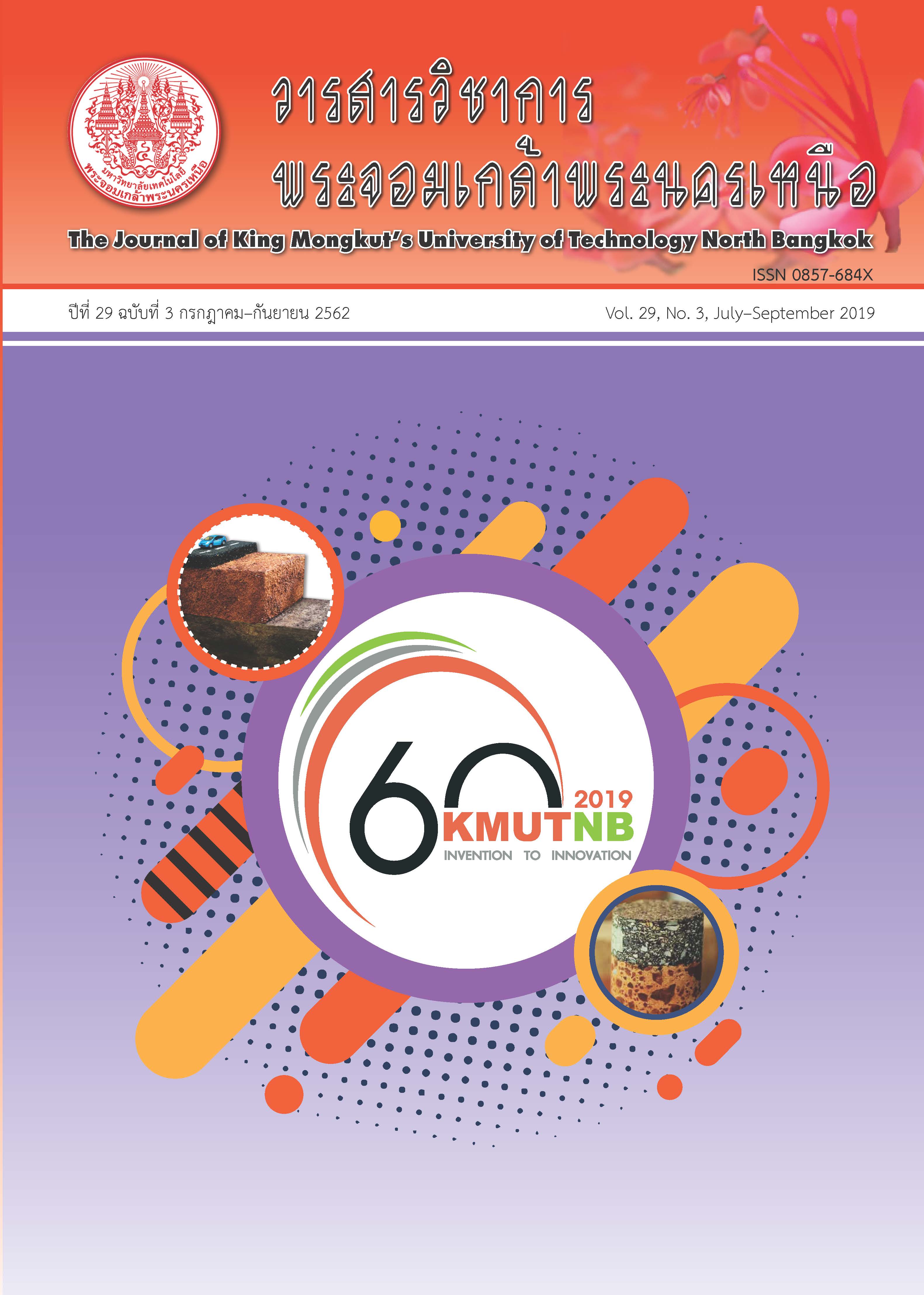Determination of Mechanical Properties of Low Carbon Steel with Hydraulic Bulge Test for Using in Hydromechanical Deep Drawing Process Simulation
Main Article Content
Abstract
This research has presented an alternative method to obtain the flow stress curve of low carbon steel sheet (SPCC) with thickness 1 mm. The objective is forming simulation result from Hydraulic bulge test to utilize Hydromechanical deep drawing process. By comparison flow stress curves that is obtained from 2 experiments as 1) Uniaxial tensile test is according to the standard of ASTM E8/E8M-09 and E646-16 that has the K value is 512.29, the n value is 0.159 and the r-Lankford value is according to the standard of ASTM E517-00 that is 1.29. And 2) Hydraulic bulge test which is formed under biaxial condition. This research did proof the mold from the research of Suwat that formed under biaxial condition is according to Membrane theory. Therefore, this mold is a reliability to use experiment data. Later, formed Hydraulic bulge test and measure parameters were employed to calculate the effective stress and strain were about 0.85 of strain level. But the Tensile test were only 0.3 of strain level. It is consistent with review other literature. When finding compatible with power law of flow stress curve from Hydraulic bulge test of low carbon steel sheet show the influence of anisotropy. It is high stress values cause that have to reduce the influence of the r-Lankford value. But due to this cannot make to find the r-Lankford value from the Hydraulic bulge test. Moreover, this have to use the r-Lankford value that is obtained from the Tensile test to the reduction of the aforementioned influence instead. This gets the K value and the nvalue that is equal to 665.04 and 0.3007. However, this brings the parameter values that are obtained from 2 experiments to simulate the forming of the parabolic work piece via Finite element method. These are compare with the forming of the real parabolic work piece. Then, this comparison is found that the parabolic work piece simulation has the distribution of the thickness in side wall of the work piece is conformed to the real forming that is the value approximate 0.755 mm at the most that this is the result of the simulation of forming with the mechanic property from the Hydraulic bulge test. It is the distribution of the thickness in side wall of the work piece simulation approximately at 0.759 mm. But the result of the simulation of forming with the mechanic property from the Tensile test has the distribution of the thickness in side wall of the work piece is approximately at 0.605 mm. This is different from the result of the real forming at 0.15 mm.
Article Details
The articles published are the opinion of the author only. The author is responsible for any legal consequences. That may arise from that article.
References
[2] ASTM International, Standard Test Methods for Tension Tesing of Metallic Materials: E8/E8M-11, 2010.
[3] K. Wiratchakul, “The reliability analysis of parabolic part quality from uncertainty of sheet metal properties,” M.S. thesis, Department of Industrial Engineering, Faculty of Engineering, King Mongkut’s University of Technology North Bangkok, 2011 (in Thai).
[4] ASTM International, Standard Test Methods for Tensile Strain-Hardening Exponents (n-Values) of Metallic Sheet Materials: E646-16, 2017.
[5] ASTM International, Standard Test Methods for Plastic Strain Ratio r for Sheet Metal: E517-00, 2010.
[6] C. Thanadngan, Metals Forming Technology, Bangkok: KMUTNB Textbook Publishing Center, 2004 (in Thai).
[7] G. Gutscher “Evaluation of formability and determination of flow stress curve of sheet metals with hydraulic bulge test,” Degree of Diploma Engineering, The Institute for Metal Forming Technology, The University of Stuttgart in collaboration with the Engineering Research Center for Net Shape Manufacturing, The Ohio State University, Columbus, Ohio State, 2000.
[8] C. Udomraksasakul, “Correction assessment of flow stress curve from hydraulic bulge test,” M.S. thesis, Department of Industrial Engineering, Faculty of Engineering, King Mongkut’s University of Technology North Bangkok, 2011 (in Thai).
[9] S. Jirathearanat, “Research and development,” MTEC, Klonglung, Pathumthani, Annual Report, 2009 (in Thai).
[10] M. Koc, E. Billur, and Ö. N. Cora, “An experimental study on the comparative assessment of hydaulic bulge test analysis methods,” Material and Design, vol.32, no. 1, pp. 272–281, 2011.
[11] C. Udomraksasakul, T. Intarakumthornchai, and S. Jirathearanat, “A study of strain condition on deformed part in hydraulic bulge test,” in Proceedings OR-NET, National Operation Research Network Conference, 2011, pp. 376–382 (in Thai).
[12] C. Boonjaeng, “Evaluation of flow stress curve from hydraulic bulge test,” M.S. thesis, Department of Industrial Engineering, Faculty of Engineering, King Mongkut’s University of Technology North Bangkok, 2012 (in Thai).
[13] G. Gutscher, H. Wu, G. Ngaile, and T. Altan, “Determination of formability and flow stress curve for sheet metals using the viscous pressure bulging (VPB) test.” Journal of Materials Processing Technology, vol. 146, no. 1, pp. 1–7, 2004.
[14] T. Intarakumthornchai, “An experiment study on the assessment of hydraulic bulge test,” STRI of KMUTNB, Bang Sue, Bangkok, July. 2011 (in Thai).
[15] T. Intarakumthornchai, “Strategies for blank holder force and pressure design through FEA simulation in sheet hydroforming,” Ph.D. dissertation, Department of Industrial Engineering, Faculty of Engineering, Chulalongkorn University, 2009.
[16] T. Intarakumthornchai and S. Jirathearanat, “Sheet hydroforming technology for automotive part cluster,” in Proceedings CIOD, the 2nd Conference of Industrial Operation Development, 2011, pp. 1–8 (in Thai).
[17] S. Suriyan, “Investigation of parabolic part forming with hydromechanical deep drawing process,” M.S. thesis, Department of Industrial Engineering, Faculty of Engineering, King Mongkut’s University of Technology North Bangkok, 2011 (in Thai).

